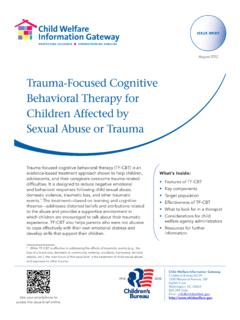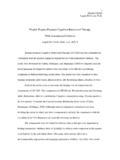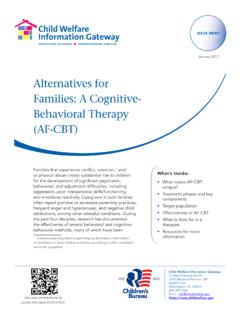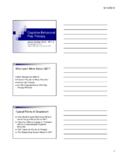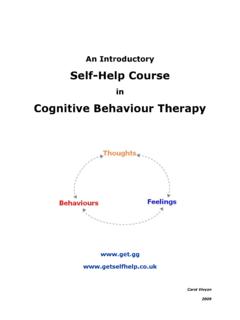Transcription of COGNITIVE BEHAVIORAL THERAPY Arron Beck Cog B
1 COGNITIVE BEHAVIORAL THERAPY . Arron beck "Cog B". Evidence Based THERAPY (CBT). The Focus on Faulty Thinking patterns Automatic Thoughts People respond to situations based on how these situations are consciously and automatically evaluated in terms of relevant underlying beliefs. Cognitions (verbal or pictorial events in a person's stream of consciousness) are based on attitudes or assumptions (schemas), developed from previous experiences. beck , Rush, Shaw, Emergy 1979. The psychological sequence progresses from evaluation to affective and motivational arousal, and finally to selection, and implementation of a relevant strategy.
2 beck , Freeman, et al. 1990. 1. Automatic thoughts. Stimuli----->Automatic thought------>Affect---- >Behavior Situation >Negative thought--->Negative Affect >Response A variety of COGNITIVE and BEHAVIORAL strategies are utilized in COGNITIVE THERAPY . COGNITIVE techniques are aimed at delineating and testing the patient's specific misconceptions and maladaptive assumptions. The approach consists of highly specific learning experiences designed to teach the patient the following operations: (1). to monitor his negative, automatic thoughts (cognitions); (2) to recognize the connections between cognitions, affect, and behavior; (3) to examine the evidence for and against his distorted automatic thoughts; (4) to substitute more reality-oriented interpretations for these biased cognitions; and (5) to learn to identify and alter the dysfunctional beliefs which predispose him to distort experiences.
3 ( beck , et al., 1979, p 4). 2. Faulty Information Processing (aka Faulty Thinking). Arbitrary Inferences: Drawing a specific conclusion in the absence of evidence to support the conclusion or when the evidence is contrary to the conclusion. Selective Abstraction: Focusing on a detail taken out of context, ignoring other more salient features of the situation and conceptualizing the whole experience on the basis of this fragment. Overgeneralization: The pattern of drawing a general rule or conclusion on the basis of one or more isolated incidents and applying the concept across the board to related and unrelated situations Magnification and Minimization: Reflected in errors in evaluating the significance or magnitude of an event that are so gross as to constitute of distortion.
4 Personalization: The patients proclivity to relate external events to himself when there is no basis for making such a connection. Absolutistic and Dichotomous Thinking: The tendency to place all experiences in one of two opposite categories;. for example, flawless or defective, immaculate or filthy, saint or sinner. In describing himself, the patient selects the extreme negative catagory. Homework 3. "Home is not just an elective, adjunct procedure. The therapist usually spends time presenting the rationale for each assignment. The importance of carrying out each assigment is stressed frequently throughout treatment.
5 ". beck , et al., 1979, p 272-273. Daily Record of Dysfunctional Thoughts Situation Emotions Automatic Thought Rational Response Outcome*. *Re-rate belief in automatic thought, 0-100%. Specify and rate subsequent emotions, 0-100%. Example of Application Treatment of Obsessive Compulsive Disorder Break Free From OCD (Challacombe et al). Obsessions are defined by recurrent and persistent thoughts, urges, or images A compulsion is defined as repetitivie behaviors ( , hand washing, ordering, checking) or mental acts ( , praying, counting, repeating words silently) that the individual feels driven to perform in response to an obsession or according to rules that must be applied rigidly 4.
6 Strategy 1. Education. 2. Self Assessment 3. Teaching that it is the personal meaning of a thought that makes it so unpleasant "But what if this key meaning [or appraisal] is not a fact at all, but a belief that can be examined? What if this key meaning is not a helpful way, or even the 'right' way of thinkng about the problem at all? OCD has convinced you for a long time that something bad may happen and that it is your responsibility to do something about it..It is important to say that striving to keep yourself and others afe is both a logical and normal response if you believe that there is danger and that you can do something about it.
7 However, we need to consider that there may be an altogether different way of thinking about the problem that you are experiencing. This is that, in fact, the problem is not one of danger at all, but one of worry about danger. Further than this, if the problem is worry about danger, then all of the very understandable measures you have been taking to avoid danger have in fact keep the problem of 5. worry going and may even have made it much worse. Challacombe, et al., 2011, p 135. 4. Learning to let thoughts go. 5. Instructing the client to think of two different ways of thinking about what is gong on, two alternative Theories: Theory A (the problem is danger) and Theory B (the problem is worry about danger).
8 Examples Theory A Theory B. My problem is that I might My problem is that I am a be careless and household careful person who appliances could catch worries about household fire and burn down the appliances catching fire house. and burning down the house. My problem is that I will My problem is that I am a get contaminated with clean person who worries dirt, disease and germs a lot that I will get and die. contaminated with dirt, disease and germs and die. 6. Learn to be objective. OCD is a problem of worry about danger not about danger itself. Consider the evidence and be careful regarding: Ambiguous or circumstantial evidence Biases Double Standard Overvaluing your responsibility Feelings as Evidence The issue of Negative reinforcement OCD is like a bully, as the threat of something bad happening is frightening enough to keep 'paying the price.
9 ' What OCD extorts from you grows over time once you have started washing your hands three times, the OCD can easily bully you into washing them five times, or ten.. Standing up to the bully is frightening at first but OCD is like most bullies the threats are just threats and if you stand up to them, they don't know what to do. Just imagine the satisfaciton, relief and pleasure you will get from standing up to this problem. Cahllacombe, et al., 2011, P 157. 7. 6. Reminding the client that "intrusive thought will continue and the need to practice "letting the thoughts go.
10 ". 7. Tolerateing some uncertainty and some anxiety. Challenging "all-or-nothing thinking" and an inflated sense of responsbility. 8.
